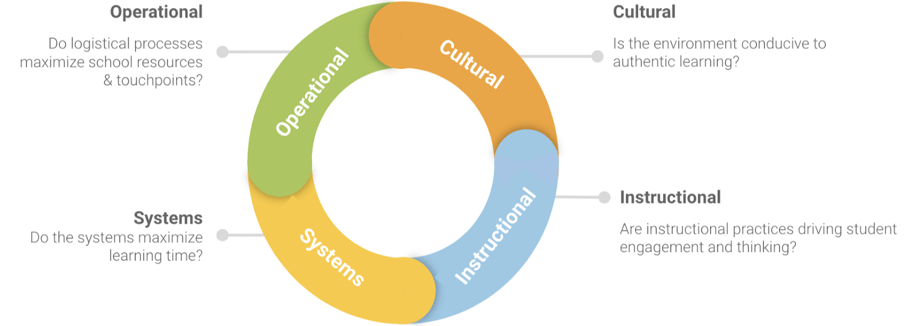
Four Types of Learning Walks for Every School Leader
Teams & Culture | Coaches | School Leadership
Everyone's first year at a new school comes with growing pains -- no matter if it’s their first role as a new Principal, or their 25th year opening a new, or newly redesigned school. One approach is particularly useful at helping to alleviate the growing pains - a “secret sauce” of sorts.
We are talking about Learning Walks - great for every school leader - but particularly useful for those new to their school building. In fact, we’ve observed that principals who monitor progress, reflect, and iterate throughout their first year are able to lay a strong foundation. Nothing shows you the impact of the choices you make and the strategy you implement quite like seeing the results firsthand.
We have found that there are four types of learning walks that allow for school and district leadership teams to drive engagement and better align instructional and cultural practices to create more effective learning environments. These four types of learning walks provide the data to help feed small cycles of continuous improvement. And they work together to drive the outcomes for student achievement in a building.

Operational Learning Walk
It is important at the beginning of the year to identify whether the structures of time, resources and people are aligned to your mission and values in each school day. Operational learning walks focus on facilities, school-wide systems and practices as well as key classroom systems that are key operational aspects of a school day.
Anchoring Questions for Operations:
- Are we maximizing student time to focus on our school values and learning?
- Are we maximizing our use of the building facilities to create spaces that align with our school's mission and values?
- Are we creating a positive learning space for both students and staff members?
Examples of Operational Focus Areas:
- Arrival and/or Dismissal
- Lunch
- PLC
- Transitions
Cultural Learning Walks
A second area of focus is determining whether, and to what extent, the student and adult actions are supporting the desired instructional culture within the school building. Cultural walks can focus on teacher actions and practices, such as positive framing and tone, or student actions, such as student engagement..
Anchoring Questions for Culture:
- Are we maximizing student time in the building to focus on learning and development?
- Are we maximizing teacher to teacher, student to teacher and student to student interactions to create an environment that aligns with our school's values and vision?
- Are we creating a positive learning space for both students and staff members to focus on instructional practices?
Examples of Culture focus areas:
- Learning Environment
- Clear Expectations and Directions
- Equity
- Parent/Community Involvement and Communication
Instructional Learning Walks
Once you have the making of a strong learning culture and operations in place, it is time to focus on whether the student and adult actions are supporting the desired instructional goals and outcomes. Instructional walks can focus more on student actions and practices to highlight trends in the execution of instructional strategies. Instructional walks are done to determine the cadence and scope of various instructional rounds within subjects and content specific practices.
Anchoring Questions for Instruction:
- Are we maximizing student time in the building to focus on tasks aligned to our academic standards?
- Are we maximizing teacher to teacher, student to teacher and student to student interactions to create a safe environment that allows for all students to grow and achieve?
- Are we creating a consistent learning space for students to learn via a variety of instructional practices?
Examples of Instructional focus areas:
- Standard Alignment
- Student + Teacher Voice
- Feedback
- Strategies
Systems Learning Walk
Finally, we look at how time, resources and people are aligned to maximize the school day for every student. The purpose of reviewing school enabling systems is to ensure that these are aligned to school goals, clarified for all stakeholders and strategically structured to maximize impact. Clear enabling systems that are formally structured, planned and monitored allow for sustained school growth throughout potential leadership transitions.
Anchoring Questions for Systems:
- Are your systems creating the space to learn, and to evolve your instructional practices through a strong collaborative culture?
- Are your systems replicable regardless of leadership or team composition?
- Are your systems clearly defined in both outcomes and expectations?
Examples of System focus areas:
- Professional Learning Communities or Teams (PLC/PLTs)
- PD meetings
- Celebrations
- Behavior Management
Overall, these four types of learning walks can be used in isolation or in small iterative cycles and differentiated in intensity or complexity based on the current status of achievement, experience and urgency of the school needs. That said, consistent practice of these walks over time can provide teachers and leadership with the data needed to know their school and hone in on crucial questions that lay the foundation for a successful school’s ecosystem.
More Leadership reading
Blog: 6 Critical Issues in Educational Leadership and How to Address Them
Blog: 3 Pillars to Build On When Opening a New School
Blog: Cultivating Leadership Effectiveness & Wellness
Blog: How School Leaders Can Empower Every Teacher to Be a Leader on Campus
Blog: Leveraging Students’ Strengths to Develop Student Leaders
About Jill Thompson & Crystal Xu
Jill is passionate about using innovative ideas to reimagine education. She is a bookaholic but also enjoys trying new restaurants and working out. Crystal partners with educators to maximize student learning through innovative approaches. A great book and beautiful florals sparks joy for her.



